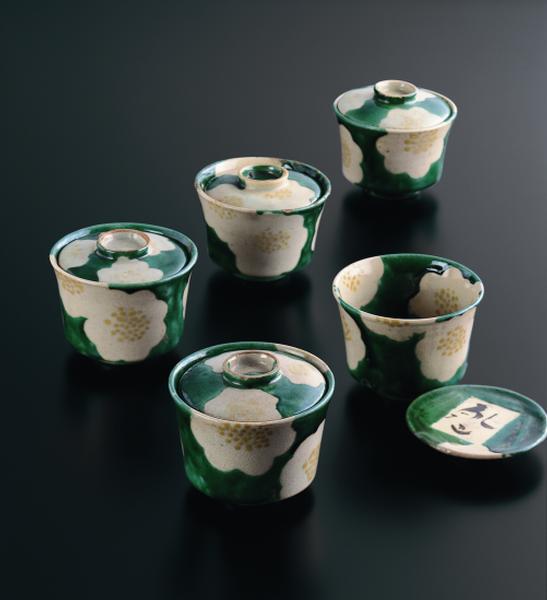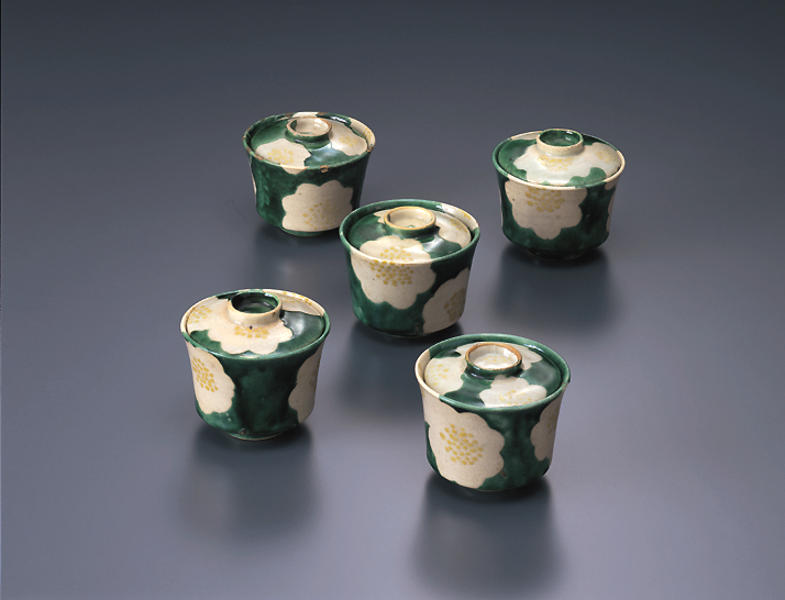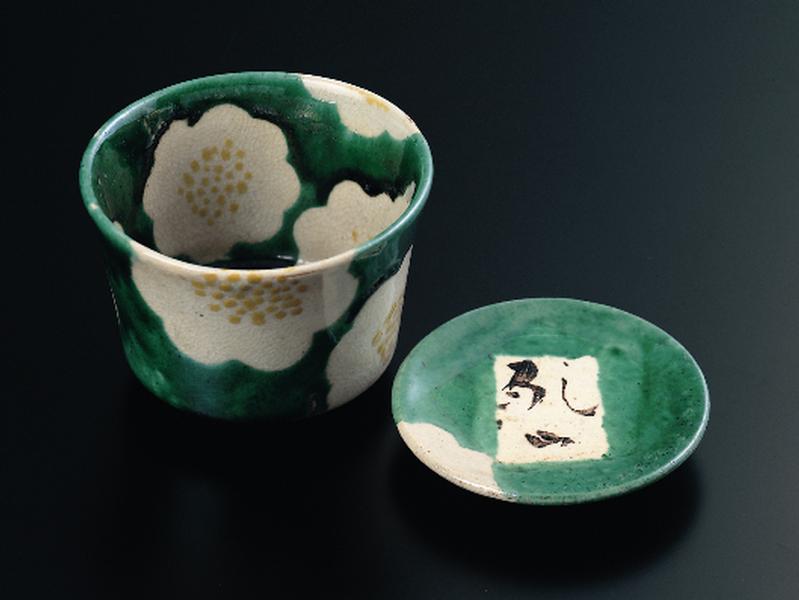乾山色絵椿文向付
- 京都
- 江戸時代
- 18世紀
- 乾山陶製、色絵
- H-7.2 D-8
江戸時代 18-19世紀
高:7.2cm 口径:8.2cm 高台径:3.8cm
全面に白化粧を施した上に,透明釉を掛けて本焼きしてから,緑の絵の具で上絵付けをしている。その際に,型紙を用いて白地を残すことによって,椿の花の輪郭を表現し,黄色の絵の具でしべを描き込んでいる。蓋の内面には,緑の絵の具の下に五角形が透け
て見えているが,これは化粧土の上に掛けた透明釉の釉層の厚さを意図的に変えること
により,あたかも段があるかのような視覚的効果を狙ったものである。
この作品のような緑地に白い椿の花を散らす意匠は,乾山焼にはしばしば見られるもので,手付鉢や数物の向付などに類品がある。しかし,「乾山」銘が蓋に書かれているのは珍しく,ほかに類例をさがすことは難しい。
銘自体は,かつて京都の三代乾山である宮田呉介の作品として紹介されたものに見られる銘の書体と類似している。呉介の銘は,江戸下向後の入谷時代の乾山の銘にならったものとされているから,いずれにしても乾山焼としては,かなり新しい時期のものであろう。 (尾野)
尾形乾山
尾形乾山(おがたけんざん 1663~1743)
乾山は、寛文3年(1663)京都の富裕な呉服商尾形宗謙(おがたそうけん)の三男として生まれました。兄は画家の光琳です。二人の性格は対象的で、光琳が派手好みであったのに対し乾山は内省的、隠遁的な性格の持主であったといわれています。
野々村仁清に陶芸を学んだ乾山は、元禄12年(1699)37歳のとき京都市の鳴滝に開窯しました。そして正徳2年(1712)50歳の乾山は、京市内の二条丁子屋町に移住し、多くの作品を手がけ「乾山焼」として世にもてはやされました。鳴滝時代の末期からこの丁子屋町時代にかけて兄の光琳は絵付で乾山を助け、兄弟合作の作品が数多く残されています。
享保16年(1731)69歳の頃に江戸に下り寛永寺(かんえいじ)領入谷(いりや)に窯を築いて晩年を送りました。そして81歳で没するまで江戸に在住し陶器や絵画の制作に手腕を発揮しました。
乾山の作品は陶芸作品のみならず書や絵画においても、俗気を脱したおおらかで文人的な洒脱味があります。陶芸作品においては成形、施釉、焼成は他の専門的な陶工に任せたり、絵付についても光琳との合作以外に複数の専門画家が携わっていたと思われるなど、基本的には工房生産という態勢をとっていたようです。しかし、乾山の指導のもとにつくられたやきものには、その大胆なデザイン感覚とともに乾山特有の芸術性が溢れ、乾山その人とふれあうような親しみが感じられるのです。
乾山銹絵染付掻落絵替汁次
乾山銹絵染付梅波文蓋物
乾山立鶴図黒茶碗
乾山銹絵染付桔梗図筒向付
乾山銹絵染付草文四方鉢
乾山銹絵染付松図茶碗
乾山色絵短冊皿
乾山銹絵絵替長平皿
乾山色絵寿字輪花向付
乾山銹絵絵替四方皿
乾山銹絵染付絵替筒向付
乾山銹絵染付松図茶碗
乾山銹絵染付春草図茶碗
乾山銹絵染付藤図向付
乾山色絵立葵図向付
乾山色絵雪杉図向付
乾山色絵桔梗文盃台
乾山銹絵馬図香合
乾山銹絵染付絵替扇形向付
乾山銹絵掻落雲唐草文大鉢
乾山銹絵草花波文水指
乾山銹絵染付絵替土器皿
乾山色絵槍梅図茶碗
乾山黒楽梅図茶碗
乾山銹絵染付芙蓉図茶碗
銹絵掻落牡丹唐草文香合
撫子図(尾形乾山筆)
乾山色絵和歌陶板
乾山色絵竜田川図向付
乾山銹絵牡丹画角皿 尾形光琳画
乾山銹絵百合形向付
乾山銹絵松文香合
乾山色絵阿蘭陀写市松文猪口
乾山色絵薄図蓋茶碗
乾山銹絵菊図水指
鶴亀図黒茶碗
紅葉図 尾形乾山筆
三十六歌仙絵/在原業平像 尾形乾山筆
三十六歌仙絵/斎宮女御像 尾形乾山筆
乾山色絵菊文手付汁次
三十六歌仙絵/小野小町像 尾形乾山筆
乾山銹絵染付山水図茶碗
Catalogue Entry
Set of 5 dishes
Edo period, 18th to 19th centuries
Kenzan ware, overglaze enamel
Height, 7.2cm; mouth diameter, 8.2cm;
foot diameter, 3.8cm
Covered entirely in a white slip, these mukozuke dishes and their covers were then coated with a transparent glaze and fired. Green pigment was then applied as an overglaze enamel technique. This green pigment was brushed over paper stencils, leaving some of the white slip-covered areas uncovered to create the outlines of white camellia blossoms. Yellow pigment was used to paint in the flowers' pistils and stamens. Pentagon-shaped areas can be seen beneath the green pigment on the inside of the lids, but as they were created through the conscious changing of the transparent glaze layer over the white slip, the stepped visual effect created by these pentagons was clearly the aim of this procedure.
The white camellias scattered on a green ground concept used in these mukozuke dishes is found occasionally in Kenzan ware, and there are related bowls with handles and sets of mukozuke dishes. The placement of the Kenzan signature on the inside of the lid is rare, and it is hard to find other comparable examples.
The signature itself resembles the calligraphy style of signatures seen on works that have been introduced as the work of Kenzan III of Kyoto, Miyata Gosuke. Miyata's signature resembles that of Kenzan's signature during his Iriya period in Edo, and it would seem that these works are probably relatively late examples during Kenzan ware. YO


